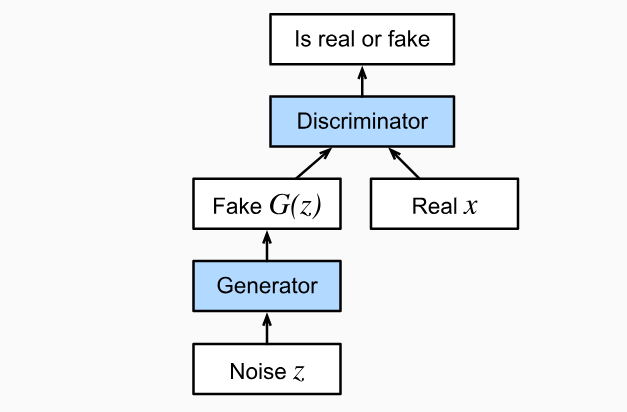- A Generative Adversarial Network relies on the following principle: a data generator is good if we cannot tell fake data from real data.

- The GAN architecture requires two parts
- A generator
that can generate synthetic data that looks like real data. It draws a latent variable from a source of randomness 1 . It then applies a function to generate - A discriminator
that can distinguish real data from fake data. It is a binary classifier that can distinguish if is from real data or from the distribution.
- A generator
- In the GAN architecture, both networks are in competition with each other.
- The generator wants to fool the discriminator.
- The discriminator wants to detect the fake data.
Training
-
Training involves alternating between training
and : is trained for one or more epochs, keeping fixed. In this way, learns to detect the flaws of . is trained for one or more epochs, keeping fixed. In this way, learns to fool . - Repeat.
-
Over time,
’s performance gets worse because the ’s accuracy (assuming gets better) converges to . This means that feedback for (which comes from ) gets worse over time and ’s performance might soon become random too. Convergence is unstable. -
and are playing a minimax function with the objective function called the minimax loss (which derives from Cross Entropy Loss) There are two issues with this:
- Vanishing Gradients
- Mode Collapse wherein the generator does not generalize. Instead, it generates a limited number of outputs — specifically the ones that seem most plausible to the discriminator. As a result, the discriminator only learns to reject those outputs.
-
An alternative loss that can be used is the Wasserstein Loss function. We modify the GAN to be a Wasserstein GAN (WGAN) where the discriminator outputs a larger number (possibly greater than
) for real instances than for fake instances. We call the discriminator of WGAN a critic. The loss function is defined as follows
An important requirements for WGAN is that weights need to remain within a constrained range;
Links
Footnotes
-
The source of randomness for the generator does not matter as long as it is random. ↩